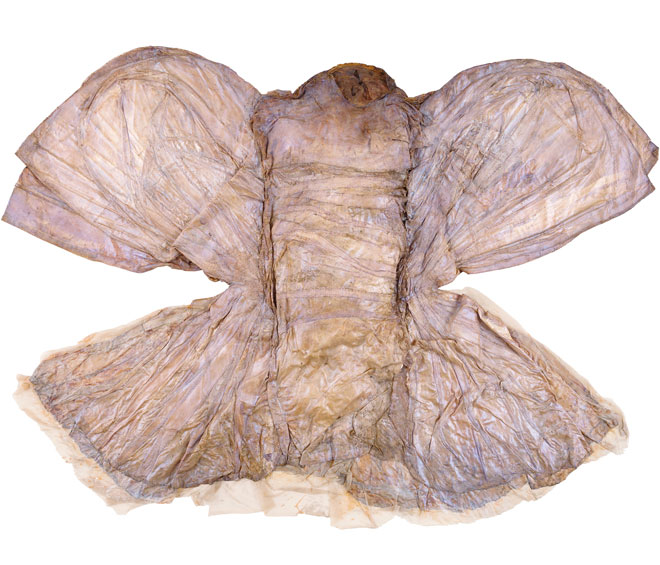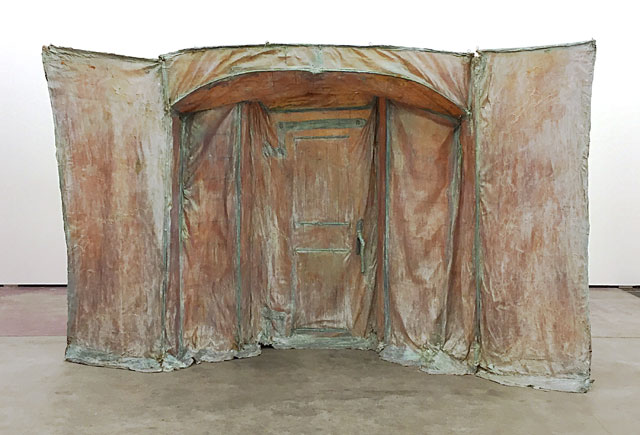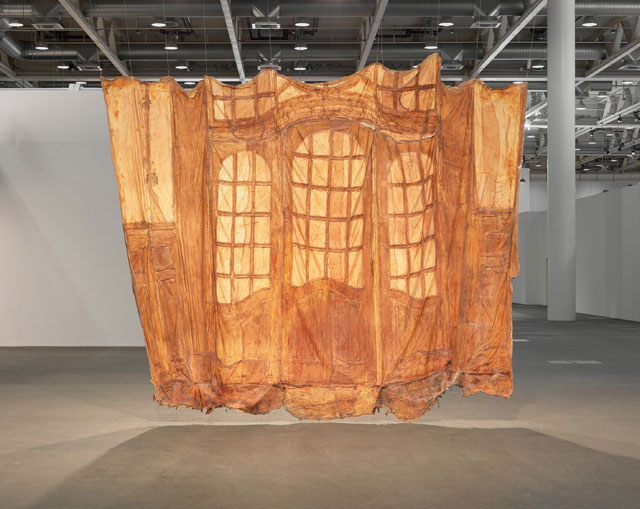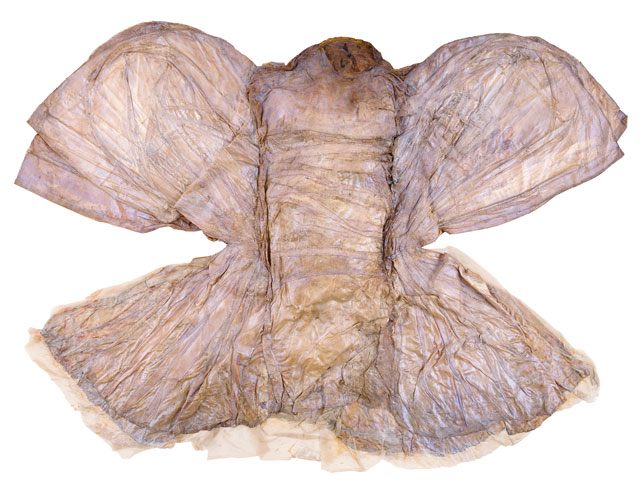
Heidi Bucher. Libellenkleid (Dragonfly costume object), 1976. Estate of Heidi Bucher. Photo: Daniele Kehr.
Parasol unit foundation for contemporary art, London
19 September – 9 December 2018
by IMOGEN GREENHALGH
Swiss artist Heidi Bucher (1926-93) made the first of her famous Raumhäute (“room skins”) in 1976. Her studio in Zurich was situated in a former butcher’s shop, and in the building’s basement was a tiled refrigeration room where meat had been stored. Bucher pasted thin sheets of gauze to the room’s entrance: its door, and the surrounding alcove. She then applied layers of liquid latex, as well as pigments of mother-of-pearl, careful to rub the aqueous material into every crevice with her hands. Once it was dry and yielding, Bucher peeled it away, sloughing the interior of its newfound skin, to produce Borg, which hangs centrally in a new survey of the artist’s work at the Parasol unit for contemporary art in London. Although it was not her first work in latex – she had previously dipped and embalmed domestic objects and clothing – it marked the start of something new for Bucher: a strange, architectural hide, somewhere between a solid structure and a supple skin.

Heidi Bucher. Borg, 1976. Textile, latex, mother-of-pearl pigments, bamboo, approx 230 x 350 x 100 cm (90½ x 137¾ x 39¼ in). Estate of Heidi Bucher. Photo: Mayo Bucher.
Bucher became preoccupied with making Häutungen (“skinnings”) such as this one during the final two decades of her life, and the body of work that resulted provides the Parasol unit show – her first in a UK public institution – with its focus. It divides her output over two floors, presenting her large-scale room skins – replicas of segments of the interiors or exteriors of buildings – on the ground floor, moving upstairs to her smaller, more intimate items, such as clothing. The variation in scale suggests the common ground shared between places and things, the way they are liable to get under our skin.
_1986.jpg)
Heidi Bucher. Heute fliesst das Wasser aus dem Krug (The water flows out of the pitcher today), 1986. Textile, latex, wood, glue, colour and mother-of-pearl pigments, approx 100 x 117 x 123 cm (39¼ x 46 x 48½ in). Estate of Heidi Bucher. Photo: Daniele Kehr.
Part of the exhibition’s appeal springs from Bucher’s evident intelligence with material (she trained as a tailor at Zurich’s School of Applied Arts) and the way she manipulates the properties of latex to produce startlingly divergent effects. The mother-of-pearl incorporated in some sculptures, Borg included, produces a restless iridescence, like oil on water, or the wing of a dragonfly, the latter a frequent symbol in her work. Elsewhere – for instance, her skinnings from Bellevue sanatorium in Kreuzlingen – the latex appears to have been layered on thickly, impasto-like, leaving behind a waxy, wrinkled pelt.
.jpg)
Heidi Bucher, installation view at Parasol unit, London, September 2018. Photo: Benjamin Westoby. Courtesy of Parasol unit foundation for contemporary art.
The material’s corporeal quality was not lost on Bucher: much of what she “skinned” related to the body in some way, from pairs of tights and nightdresses to a cast of a double bed with the pinky, mottled quality of bruised flesh. In other works, there is less of the human body, and more of the natural world: doors skinned in Lanzarote (three of these are included in the show) recall the bark of trees, while the exterior of Bellevue, with its imbricated tiles, gives the impression of scales, supple and a little reptilian.
_1975.jpg)
Heidi Bucher. Anna Mannheimer mit Zielscheibe (Anna Mannheimer with Target), 1975. Latex, cotton, mother-of-pearl pigment, 213 x 200 x 2 cm (83¾ x 78¾ x ¾ in). Estate of Heidi Bucher. Photo: Daniele Kehr.
In rendering each of these surfaces as a kind of textile, Bucher calls attention to the slipperiness of her task. How might we glean meaning from the external surfaces of things? However suggestive they, or the place they belong to, may be, they remain superficial, and inscrutable as a result. A set of undergarments retrieved from a prison and mummified (The Hatching of the Parquet Dragonfly,1983) tells us nothing of its wearer. And yet even as Bucher preoccupies herself with surfaces, shrugging off the artist’s stake in interiority, she reminds the viewer of the inroads art can create into matters that remain elusive, ineffable, always hovering just out of view. As she stands outside her subjects, embalming their outer limits, she allows us to trespass, our imaginations put to work.

Heidi Bucher. Kleines Glasportal, Bellevue Kreuzlingen (Small glass portal, Bellevue Kreuzlingen), 1988. Textile, latex, approx 340 x 465 cm (133¾ x 183 in) . Estate of Heidi Bucher. Installation views at Art Basel Unlimited, 2016. Photo: Robert Glowacki, courtesy The Approach, London.
One highlight within the show is the chance to see four short films made of Bucher’s work, including two that document her skinning process. The immense labour that goes into it is striking: it takes Bucher all her physical strength to flay the dried latex from the building’s walls. In filming this, Bucher goes beyond a simple recording of the practicalities of the making process; the act of skinning becomes a part of the final work. In Bellevue, Kreuzlingen (1990), filmed by Michael Koechlin, we watch as she wraps the rubbery hide around her like a shroud; in another scene, she dons it as a cape like a victor in battle. Akin to an exorcism, there is a deliberately performative aspect to it, with Bucher once describing it as such: “Peeling off the skin is detachment from the past. From marked matter, from conventions and other compulsions. I’m freed from the things that surrounded me.”
.jpg)
Heidi Bucher, installation view at Parasol unit, London, September 2018. Photo: Benjamin Westoby. Courtesy of Parasol unit foundation for contemporary art.
While it is tempting to read this as a handy definition of Bucher’s work, she was rarely literal about things, and truth seems more likely to reside somewhere in between these words, in a place rather more subtle and peculiar. Like the sculptor Eva Hesse, with whom productive parallels can be made, Bucher knew latex to be volatile, turning brittle and degrading with age. Once her skin was made, it was not fixed, and sidestepping sculpture’s memorial function, none was designed, ultimately, to endure. Within the exhibition, you bear witness to the signs of this: cracks and flakes coming loose, crumples forming round the edges. Through this slow decay, Bucher brings us closest to the provisional nature of memory that she was trying to describe. As we carry our past around with us, it creases and crinkles, losing its shape, little by little, along the way.

Heidi Bucher. Libellenkleid (Dragonfly costume object), 1976. Textile, latex and mother-of-pearl pigments, approx 246 x 295 x 15 cm (96¾ x 116¼ x 6 in). Estate of Heidi Bucher. Photo: Daniele Kehr.